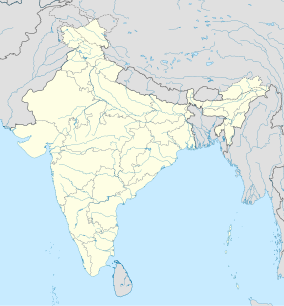Mrugavani National Park
| Mrugavani National Park | |
|---|---|
Pied Cuckoo at Mrugavani National Park | |
| Location | Chilkur near Hyderabad, Telangana |
| Nearest city | Hyderabad |
| Coordinates | 17°21′19″N 78°20′17″E / 17.355228°N 78.338159°E |
| Area | 1,211 acres (4.90 km2) |
| Created | 1994 |
Mrugavani National Park is a
Flora and Fauna
Flora
Some of the plants that are found in the park are
- Teak
- Bamboo
- Sandalwood
- Ficus
- Palash and
- Rela.
Other flora
The plant species include bryophytes, Pteridophytes, Herbs, Shrubs, Climbers and Trees. The vegetative cover presents a mosaic of woodland and grasslands. The plants of the park is of tropical waterless deciduous forest of degraded nature.
Fauna
Mammals
The mammals which are found here are
Reptiles
Some of the reptiles that are found in the park are given below-
Birds

Apart from the varied flora and fauna the Mrugavani National Park boasts of more than 100 species of birds including warblers, peacocks, babblers, koels, lapwings, and flowerpeckers.
Park-specific Information
The park was declared as a national park in 1994.
The climate here is pleasant most of the time. There is a point in the park which is at a height for high point views and there is also a watch tower so as to watch animals closely.
There is also a library and Education center in regard to the Environment a museum and auditorium which exhibits wildlife. Visitors may also go for safari rides for those willing to get closer to the park's denizens, besides nature walks with guides.
The topography of Park supports woodlands, grasslands and rocky areas. Most of the vegetation can be classified as southern tropical dry deciduous forests. The Park does the significant job of conserving the near disappearing native flora of Hyderabad region.
The undulating topography shows the rocky side of the formation of the Deccan trap.
Seasons
Winter – November to February
Summer – March to May
Monsoon – June to October
Average rainfall: 300 to 750 mm
Temperature: Maximum 40 °C, Minimum 10 °C
Coordinates: 17° 21’ 27.79″ N, 78° 20’ 26.91″ E
Location
The Park is in near
See also
References
- ^ "Wild Life in Telangana :: Telangana Tourism". telanganatourism.gov.in. Retrieved 18 April 2018.
- ^ Borah, Prabalika M. (11 January 2018). "Dear, how about some deer spotting?". Retrieved 18 April 2018 – via www.thehindu.com.
External links
- Forest Department description (archived 8 January 2012)



